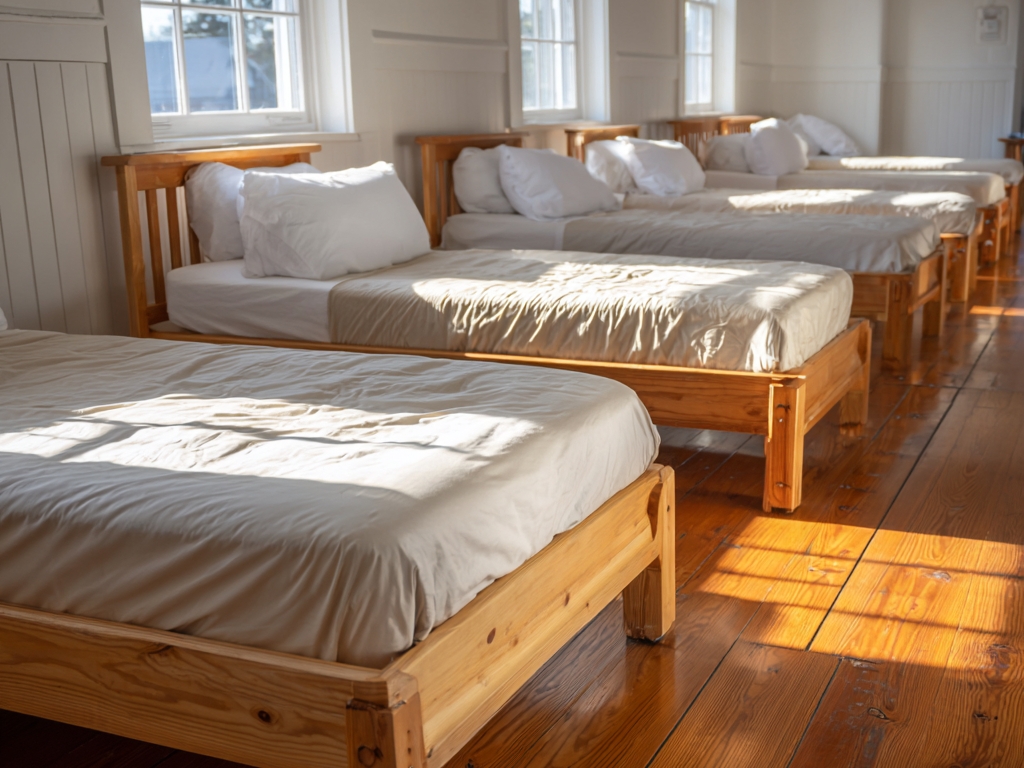When we think about the role of mattresses, most of us picture them in personal spaces—our homes, bedrooms, or hotels. However, in institutional and community-focused environments such as shelters, missions, and firehouses, mattresses take on a different role. Here, they aren’t just about personal comfort; they’re about safety, durability, hygiene, and cost-efficiency.
For organizations that provide housing and care—whether for the unhoused, emergency responders, or transitional residents—the choice of mattress can directly impact operational success.
Let’s explore how shelter mattresses, mission mattresses, and firehouse mattresses are evolving to meet the demanding needs of these environments.
Why Mattress Selection Matters in Institutional Settings
In high-occupancy environments, mattresses experience significantly more wear and tear compared to residential use.
A typical home mattress might last 8–10 years with one or two users. In a shelter or mission, that same lifespan shrinks dramatically due to:
- Frequent turnover of users
- 24/7 usage cycles
- Hygiene and sanitation requirements
- Exposure to a higher risk of spills, stains, or even bed bugs
For firehouses, durability and resilience are equally important. Firefighters often need quick, uninterrupted rest during unpredictable hours, and their mattresses must support health and recovery in physically demanding roles.
Key Features of Shelter and Mission Mattresses
Organizations choosing shelter mattresses need to look beyond comfort and focus on functionality and compliance. The following features are often non-negotiable:
1. Vinyl or Waterproof Covers
These prevent absorption of spills and bodily fluids, making them easy to clean and sanitize. In mission and shelter environments, this drastically reduces the risk of contamination and extends mattress life.
2. Flame Resistance
Fire safety is critical, particularly in large group housing environments. Fire-retardant materials help organizations meet compliance requirements and protect residents.
3. Durability and Compression Resistance
Mattresses designed for institutional use often incorporate high-density foam that resists sagging, even under heavy use.
4. Bed Bug and Pest Resistance
Sealed seams and specialized fabrics minimize the risk of infestations, an issue that can disrupt entire facilities and rack up remediation costs.
5. Affordable Replacement Cycles
Since organizations often purchase mattresses in bulk, affordability is essential. Choosing long-lasting, easy-to-maintain options reduces replacement frequency and overall budget strain.
Firehouse Mattresses: Built for Performance and Recovery
While shelter and mission mattresses emphasize hygiene and resilience, firehouse mattresses lean more toward performance and recovery. Firefighters live and sleep in their stations for extended periods, and their rest directly affects how quickly and effectively they can respond to emergencies.
A good firehouse mattress should:
- Support musculoskeletal recovery after long, strenuous shifts
- Provide medium-to-firm comfort to accommodate multiple users over time
- Incorporate breathable and easy-clean covers for a balance of hygiene and comfort
- Maintain structural integrity despite frequent, short-duration sleep cycles
Here, mattresses are not just a facility cost—they’re part of the wellness equation for first responders.
Balancing Cost and Quality in Bulk Purchases
For nonprofits, missions, and shelters, mattress purchases often come from grant funding or tight operating budgets. This makes cost-efficiency a priority, but cutting corners can be counterproductive. Low-cost mattresses that wear out quickly or require intensive cleaning can cost more in the long run.
A total cost of ownership (TCO) approach is best:
- Factor in replacement cycles—a higher-quality mattress may outlast two or three cheaper models.
- Include cleaning and maintenance costs—waterproof or wipeable surfaces lower ongoing expenses.
- Assess resident satisfaction and health—better sleep can translate into improved well-being, faster recovery, and reduced complaints.
Sustainability in Shelter and Firehouse Bedding
An emerging conversation in institutional bedding is sustainability. While vinyl-covered mattresses are often the standard, organizations are exploring materials that balance durability with environmental impact.
Some manufacturers now offer recyclable or low-VOC (volatile organic compound) materials, appealing to shelters and missions that want to align with eco-conscious goals.
For firehouses, sustainability ties into broader municipal initiatives around green building and procurement policies. Choosing mattresses with longer lifespans and reduced landfill impact can help organizations meet both fiscal and environmental goals.
Practical Considerations When Sourcing Shelter Mattresses
If you’re responsible for sourcing mattresses for a mission, shelter, or firehouse, here are a few practical steps to streamline the process:
- Define the Use Case – Is this for short-term transitional housing, long-term shelter, or emergency services? Each requires slightly different performance priorities.
- Check Compliance Standards – Ensure mattresses meet local fire codes, health regulations, and safety certifications.
- Request Bulk Pricing and Samples – Most vendors will provide institutional discounts and product samples to evaluate before committing.
- Prioritize Hygiene – Choose mattresses that can be quickly sanitized to reduce downtime between occupants.
- Plan Storage and Replacement Cycles – Having backup units ready ensures seamless transitions when replacements are needed.
Looking Ahead: The Future of Institutional Mattresses
The needs of shelters, missions, and firehouses are evolving. Rising awareness of mental health, recovery, and wellness means that mattresses are no longer seen as “just furniture.” Instead, they are recognized as essential infrastructure.
Advancements in foam technology, antimicrobial fabrics, and modular mattress designs will likely define the next generation of institutional bedding. Firehouses may lean toward hybrid foams for recovery, while shelters may benefit from mattresses that combine affordability with sustainability.
Frequently Asked Questions
Q1. What type of mattresses are best for shelters and missions?
Shelters and missions often need mattresses that are durable, easy to clean, flame-resistant, and affordable in bulk. Vinyl-covered or waterproof mattresses are popular because they withstand heavy use and can be sanitized quickly.
Q2. How do firehouse mattresses differ from regular mattresses?
Firehouse mattresses are designed for durability, hygiene, and physical recovery. Unlike home mattresses, they support multiple users, allow easy cleaning, and provide the firmness needed for firefighters to rest effectively between shifts.
Q3. Why is hygiene such an important factor for shelter mattresses?
In high-turnover environments like shelters and missions, mattresses face exposure to spills, stains, and pests. Easy-clean covers and sealed seams reduce health risks, lower maintenance costs, and extend mattress life.
Q4. Are there safety regulations for mission and firehouse mattresses?
Yes. Most institutional mattresses must meet fire safety standards and health codes. Flame-retardant materials and compliant designs help organizations ensure occupant safety and avoid regulatory issues.
Q5. How can organizations balance budget and quality when buying shelter mattresses?
While cost is a concern, looking at the total cost of ownership (TCO) is key. Durable, wipeable mattresses may have a higher upfront cost but save money long term by reducing replacements and cleaning expenses.
Conclusion
For organizations serving vulnerable populations or supporting emergency responders, mattresses are not a small detail—they are a cornerstone of safety, hygiene, and dignity.
Shelter mattresses, mission mattresses, and firehouse mattresses must balance affordability with durability, hygiene, and compliance.
By investing wisely, organizations can extend the lifespan of their bedding, improve occupant comfort, and reduce long-term costs. In settings where rest and recovery directly impact lives, the right mattress choice makes all the difference.

